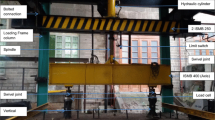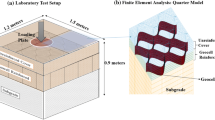Abstract
This study investigates the cyclic loading behaviour of a two-layered unpaved road model reinforced with untreated/treated woven and non-woven coir geotextiles over 10,000 cycles. In this study, research efforts were made to develop artificial-neural-network (ANN)-based prediction models for the plastic deformation of untreated/treated coir geotextile-reinforced unpaved road models. Pearson's coefficient of correlation (R2) and the root mean square error (RMSE) was utilized to evaluate the predictive accuracy of the predictive models. Key discoveries include a substantial reduction in plastic deformation for the reinforced two-layered unpaved road models (Types W1, W2, NW1, and NW2), showcasing decreases of 69%, 74%, 58%, and 66%, respectively, compared to the unreinforced model, particularly in unsoaked conditions. The results demonstrated reduction in the plastic deformation in treated coir geotextiles reinforced models. The study reveals an escalation in plastic deformation at 60% cyclic load as opposed to 30%, evident in both unsoaked and soaked conditions. The selected neural network model exhibits high accuracy, with R2 values exceeding 0.95 and RMSE values below 1, indicating precise prediction of plastic deformation of untreated/treated coir geotextile-reinforced unpaved road model.
















Similar content being viewed by others
References
World, B. (2008). Safe, clean and affordable transport for development. WB Group’s Transport Business Strategy.
Vivek, Dutta, R. K., & Parti, R. (2020). Effect of chemical treatment on the tensile strength behavior of coir geotextiles. Journal of Natural Fibers, 17(4), 542–556. https://doi.org/10.1080/15440478.2018.1503132
Shirazi, M. G., Rashid, A. S. B. A., Nazir, R. B., Rashid, A. H. B. A., Moayedi, H., Horpibulsuk, S., & Samingthong, W. (2020). Sustainable soil bearing capacity improvement using natural limited life geotextile reinforcement—A review. Minerals, 10(5), 479. https://doi.org/10.3390/min10050479
Unnikrishnan, N., Rajagopal, K., & Krishnaswamy, N. R. (2002). Behaviour of reinforced clay under monotonic and cyclic loading. Geotextiles and Geomembranes, 20(2), 117–133. https://doi.org/10.1016/S0266-1144(02)00003-1
Dutta, R. K., & Rao, G. V. (2008). Potential of coir based products as soil reinforcement. International Journal of Earth Sciences and Engineering, 71, 79.
Vivek, Dutta, R. K., & Parti, R. (2019). Application potential of treated Coir Geotextiles in unpaved roads. Journal of Natural Fibers. https://doi.org/10.1080/15440478.2019.1578718
Baadiga, R., Balunaini, U., Saride, S., & Madhav, M. R. (2022). Behavior of geogrid- and geocell-stabilized unpaved pavements overlying different subgrade conditions under monotonic loading. International Journal of Geosynthetics and Ground Engineering. https://doi.org/10.1007/s40891-022-00379-x
Vivek, Dutta, R. K., & Parti, R. (2021). Bearing ratio behavior of sand overlying clay with treated coir geotextiles at the interface. Journal of Natural Fibers, 0478(2021), 1952135. https://doi.org/10.1080/1544
Adeniyi, A. G., Onifade, D. V., Ighalo, J. O., & Adeoye, A. S. (2019). A review of coir fiber reinforced polymer composites. Composites, Part B: Engineering, 176, 1–10. https://doi.org/10.1016/j.compositesb.2019.107305
Sajikumar, P. R. (2014). Structural performance of coir geotextile reinforced rural roads. International Journal of Scientific and Engineering Research, 5(7), 278–282.
Sayida, M. K., Evangeline, S. Y., & Girish, M. S. (2020). Coir geotextiles for paved roads: A laboratory and field study using non-plastic soil as subgrade. Journal of Natural Fibers, 17(9), 1329–1344. https://doi.org/10.1080/15440478.2019.1568344
Sumi, S. S., Unnikrishnan, N., & Mathew, L. (2018). Durability studies of surface-modified coir geotextiles. Geotextiles and Geomembranes, 46(6), 699–706. https://doi.org/10.1016/j.geotexmem.2018.07.007
Vivek, Dutta, R. K., & Parti, R. (2019). Effect of chemical treatment of the coir geotextiles on the interface properties of sand–/Clay–coir geotextile interface. Journal of Institute of Engineering India Series A, 100(2), 357–365. https://doi.org/10.1007/s40030-018-0348-x
Rout, J., Misra, M., Tripathy, S., et al. (2001). The influence of fiber surface modification on the mechanical properties of coir-polyester composites. Polymer Composites, 22(4), 468–476. https://doi.org/10.1016/S0266-3538(01)00021-5
Rahman, M. M., & Khan, M. A. (2007). Surface treatment of coir (Cocos nucifera) fibers and its influence on the fibers physico-mechanical properties. Composites Science and Technology, 67(11–12), 2369–2376. https://doi.org/10.1016/j.compscitech.2007.01.009
Abdullah, N. M., & Ahmad, I. (2012). Effect of chemical treatment on mechanical and water-sorption properties coconut fiber-unsaturated polyester from recycled PET. International Scholarly Research Notices, 2012, article ID 134683, 8 pages. https://doi.org/10.5402/2012/134683
Anggraini, V., Asadi, A., Farzadnia, N., Jahangirian, H., & Huat, B. B. K. (2016). Effects of coir fibres modified with Ca(OH)2 and Mg(OH)2 nanoparticles on mechanical properties of lime-treated marine clay. Geosynthetics International, 23(3), 206–218. https://doi.org/10.1680/jgein.15.00046
Rout, S. (2018). Fabrication of transesterified cured coir reinforced composites and evaluation of their propertie. International Journal of Multidisciplinary, 3(9), 502–507.
Farias, J., Cavalcante, R., Canabarro, B., Viana, H., Scholz, S., & Simão, A. (2017). Surface lignin removal on coir fibers by plasma treatment for improved adhesion in thermoplastic starch composites. Carbohydrate Polymers. https://doi.org/10.1016/j.carbpol.Retrieved2017/2/42,8617,0144
Narendar, R., & Dasan, P. K. (2013). Chemical treatments of coir pith: Morphology, chemical composition, thermal and water retention behavior. Composites. https://doi.org/10.1016/j.compositesb.2013.09.028
Sumi, S., Unnikrishnan, N., & Mathew, L. (2017). Surface modification of coir fibers for extended hydrophobicity and antimicrobial property for possible geotextile application. Journal of Natural Fibers, 14(3), 335–345. https://doi.org/10.1080/15440478.2016.1209714
Rajagopal, K., & Ramakrishna, S. (2009). Coir geotextiles as separation and filtration layer for low intensity roadbases. In Proceeding of Indian Geotechnical Conference, Guntur, Andhra Pradesh, India, December 17–19.
Ramasubbarao, G. (2014). Strength behaviour of kerosene coated coir fiber-reinforced expansive soil. Facta Universitatis – Series: Architecture and Civil Engineering, 12(2), 113–120. https://doi.org/10.2298/FUACE1402113R
Samui, P. (2012). Application of statistical learning algorithms to ultimate bearing capacity of shallow foundation on cohesionless soil. International Journal for Numerical and Analytical Methods in Geomechanics, 36(1), 100–110. https://doi.org/10.1002/nag.997
Zhou, J., Shi, X., Du, K., Qiu, X., Li, X., & Mitri, H. S. (2017). Feasibility of random-forest approach for prediction of ground settlements induced by the construction of a shield-driven tunnel. International Journal of Geomechanics, 17(6), 04016129. https://doi.org/10.1061/(ASCE)GM.1943-5622.0000817
Shu, Z., Ning, B., Chen, J., Li, Z., He, M., Luo, J., & Dong, H. (2023). Reinforced moment-resisting glulam bolted connection with coupled long steel rod with screwheads for modern timber frame structures. Earthquake Engineering and Structural Dynamics, 52(4), 845–864. https://doi.org/10.1002/eqe.3789
Magerman, D. M. (1995). Statistical decision-tree models for parsing. In Proceedings of the 33rd Annual Meeting on Association for Computational Linguistics, Cambridge, MA, United States 276–283. Association for Computational Linguistics. https://doi.org/10.3115/981658.981695
Juang, C. H., Lee, D. H., & Sheu, C. (1992). Mapping slope failure potential using fuzzy sets. Journal of Geotechnical Engineering, 118(3), 475–494. https://doi.org/10.1061/(ASCE)0733-9410(1992)118:3(475)
Scull, P., Franklin, J., & Chadwick, O. A. (2005). The application of classification tree analysis to soil type prediction in a desert landscape. Ecological Modelling, 181(1), 1–15. https://doi.org/10.1016/j.ecolmodel.2004.06.036
Shahriar, K., Sharifzadeh, M., & Hamidi, J. K. (2008). Geotechnical risk assessment based approach for rock TBM selection in difficult ground conditions. Tunnelling and Underground Space Technology, 23(3), 318–325. https://doi.org/10.1016/j.tust.2007.06.012
Hua, W., Yu, Q., Xiao, Y., Li, W., Wang, M., Chen, Y., & Li, Z. (2022). Development of artificial-neural-network-based permanent deformation prediction model of unbound granular materials subjected to moving wheel loading. Materials, 15(20), 7303. https://doi.org/10.3390/ma15207303
Oskooei, P. R., Mohammadinia, A., Arulrajah, A., & Horpibulsuk, S. (2020). Application of artificial neural network models for predicting the resilient modulus of recycled aggregates. International Journal of Pavement Engineering, 298436(2020), 1791863.
Vinodh Kumar, S., & Balaji, S. (2016). Artificial neural network modelling and economic analysis of Black cotton soil subgrade stabilized with fly ash and geotextile. International Journal of Earth Sciences and Engineering, 9(1), 81–86.
Ismael, M. Q., Joni, H. H., & Fattah, M. Y. (2022). Neural network modeling of rutting performance for sustainable asphalt mixtures modified by industrial waste alumina. Ain Shams Engineering Journal, 14, 101972.
Ullah, S., & Zainab, B. (2020). Development of an artificial neural network (ANN)-based model to predict permanent deformation of base course containing reclaimed asphalt pavement (RAP). Road Materials and Pavement Design. https://doi.org/10.1080/14680629.2020.1773304
Qadir, A., Gazder, U., & Un Nisa Choudhary, K. (2020). Artificial neural network models for performance design of asphalt pavements reinforced with geosynthetics. Transportation Research Record. https://doi.org/10.1177/0361198120924387
Jaswal, P., & Vivek. (2023). Experimental study on monotonic behaviour of two layered unpaved road model reinforced with treated coir geotextiles. International Journal of Pavement Research and Technology. https://doi.org/10.1007/s42947-023-00293-z
ASTM D4595. (2017). ASTM International. Standard test method for tensile properties of geotextiles by the wide-width strip method
Jaswal, P., Vivek, & Sinha, S. K. (2022). Investigation on tensile strength characterisation of untreated and surface treated coir geotextiles. Journal of Industrial Textiles. https://doi.org/10.1177/15280837221118847
Jaswal, P., Vivek, & Sinha, S. K. (2022). Improvement in the performance of two layered model pavement with treated coir geotextile at the interface. Journal of Industrial Textiles. https://doi.org/10.1177/15280837221114161
Jaswal, P., Vivek, & Sinha, S. K. (2023). Laboratory analysis of the interface shear characteristics of chemically treated coir geotextiles and soil interface. International Journal of Pavement Research and Technology. https://doi.org/10.1007/s42947-023-00369-w
ASTM D1557. (2021). ASTM International. Standard Test Methods for Laboratory Compaction Characteristics of Soil Using Modified Effort
ASTM D4318. (2017). ASTM International. Standard test methods for liquid limit, plastic limit, and plasticity index of soils
ASTM D854. (2002). ASTM International. Standard test methods for specific gravity of soil solids by water pycnometer
ASTM D7928. (2021). ASTM International. Standard test method for particle-size distribution (gradation) of fine-grained soils using the sedimentation (hydrometer) Analysis
ASTM D1883-21. (2021). ASTM International. Standard. Test method for California bearing ratio (CBR) of laboratory-compacted soils
Vivek, Sehgal, R. S., & Mir, M. S. (2022). Studies of modulus of resilience on unpaved roads reinforced with untreated/treated coir geotextiles. Journal of Natural Fibre. https://doi.org/10.1080/15440478.2022.2101041
Frank, I. E., & Todeschini, R. (1994). The data analysis handbook. Elsevier.
Silva, D. L., Jesus, D. V., Adina, E. M., Mangrobang, D. V., Escalante, M. D., & Susi, N. A. M. (2021). Prediction of tensile strength and erosional effectiveness of natural geotextiles using artificial neural network. In 13th International Conference on Computer and Automation Engineering (ICCAE). https://doi.org/10.1109/ICCAE51876.2021.9426170.
Vivek, Dutta, R. K., & Parti, R. (2019). Effect of chemical treatment of the coir geotextiles on the interface properties of sand–/Clay–coir geotextile interface. Journal of the Institution of Engineers (India): Series A, 100(2), 357–365. https://doi.org/10.1007/s40030-018-0348-x
Arabani, M., & Haghsheno, H. (2020). The effect of water content on shear and compressive behavior of polymeric fiber- reinforced clay. SN Applied Sciences. https://doi.org/10.1007/s42452-020-03568-3
Kang, Q., Xia, Y., Li, X., Zhang, W., & Feng, C. (2022). Study on the effect of moisture content and dry density on shear strength of silty clay based on direct shear test. Advances in Civil Engineering, 2022, 1–9. https://doi.org/10.1155/2022/2213363
Acknowledgements
We are thankful to the National Institute of Technology, Jalandhar for the opportunity to conduct research. Our heartfelt thanks to family and friends for their unending love, assistance, and support.
Funding
The author(s) received no financial support for the research, authorship, and/or publication of this article.
Author information
Authors and Affiliations
Corresponding author
Ethics declarations
Conflict of interest
No potential conflict of interest was reported by the author(s).
Rights and permissions
Springer Nature or its licensor (e.g. a society or other partner) holds exclusive rights to this article under a publishing agreement with the author(s) or other rightsholder(s); author self-archiving of the accepted manuscript version of this article is solely governed by the terms of such publishing agreement and applicable law.
About this article
Cite this article
Vivek, Jaswal, P. Evaluation of Untreated and Treated Coir Geotextile Performance under Cyclic Loading on Unpaved Roads. Int. J. Pavement Res. Technol. (2024). https://doi.org/10.1007/s42947-024-00430-2
Received:
Revised:
Accepted:
Published:
DOI: https://doi.org/10.1007/s42947-024-00430-2




